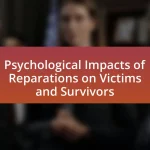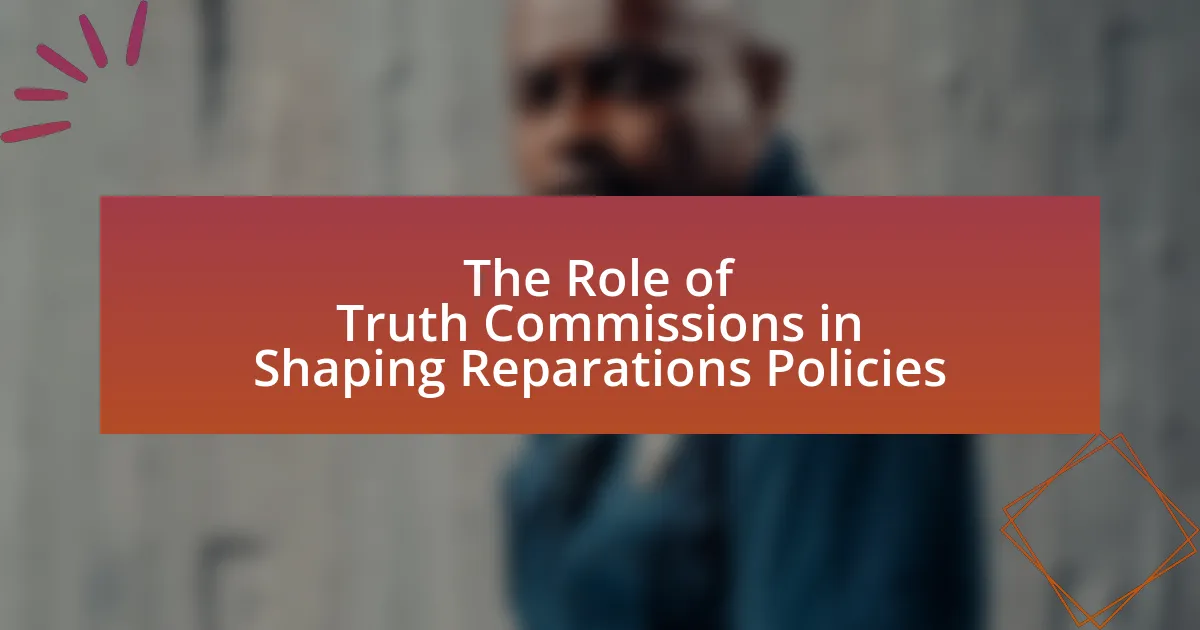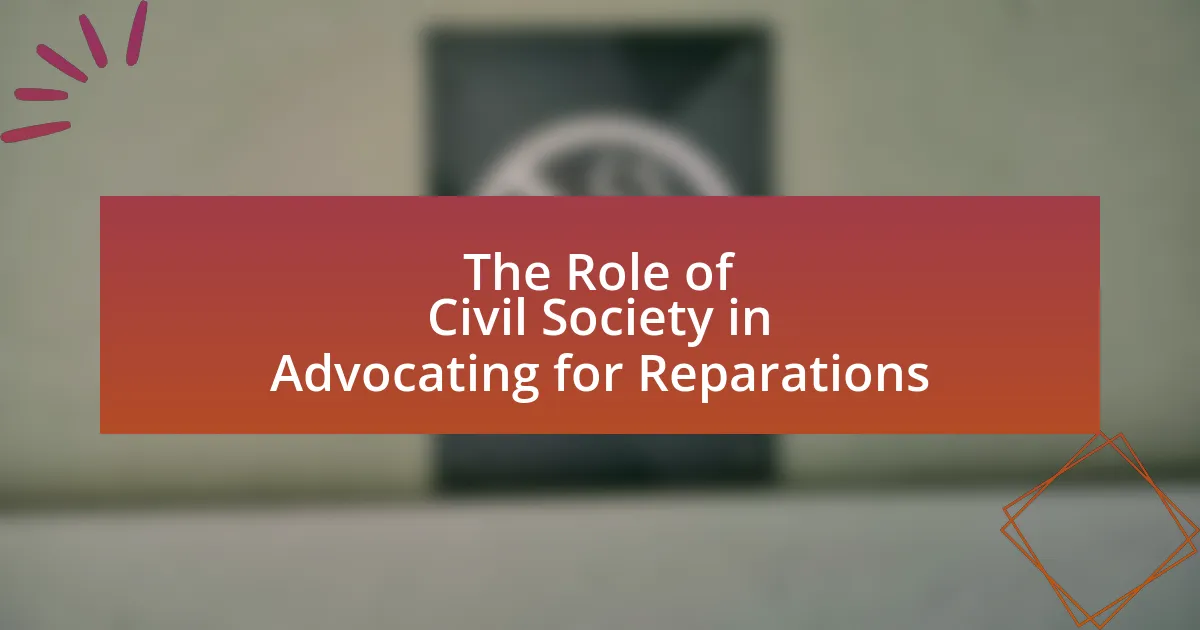Legal frameworks for implementing restorative justice in transitional justice encompass statutes, international treaties, and national laws designed to facilitate reconciliation and accountability following conflicts or systemic injustices. These frameworks establish mechanisms such as truth commissions, reparations programs, and community-based restorative practices, which aim to address the harms inflicted on victims and promote societal healing. Key principles of restorative justice, including accountability, repair, and stakeholder involvement, align with transitional justice goals by emphasizing the importance of victim participation and community engagement. The article explores the necessity of legal frameworks, the challenges faced without them, and best practices for enhancing their effectiveness in achieving restorative justice outcomes.
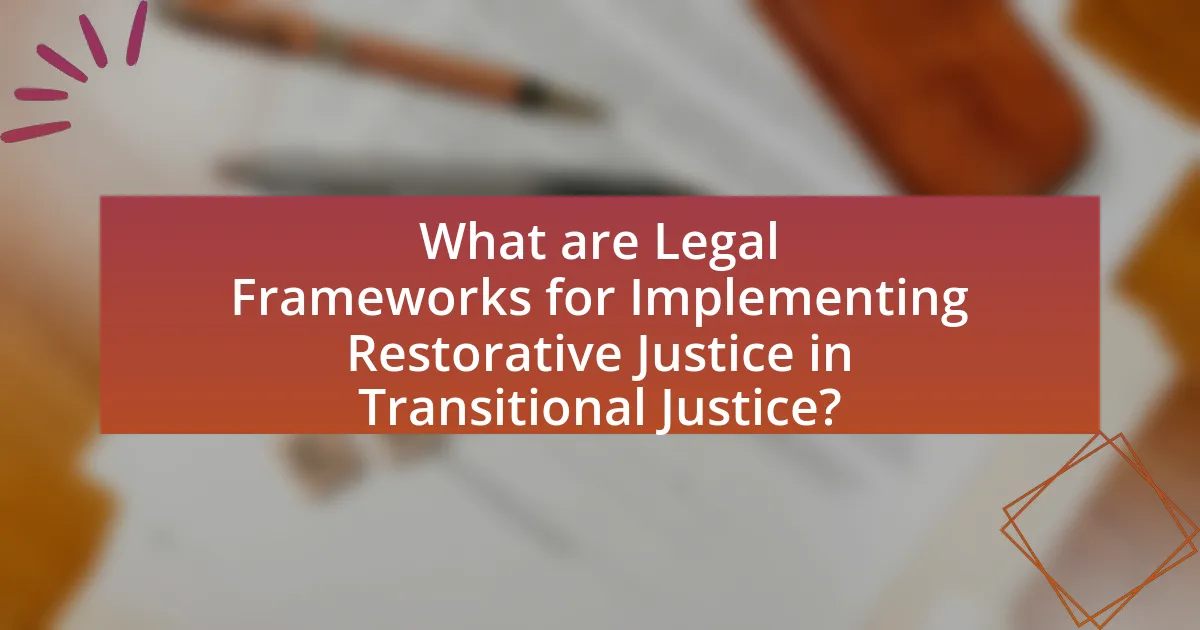
What are Legal Frameworks for Implementing Restorative Justice in Transitional Justice?
Legal frameworks for implementing restorative justice in transitional justice include statutes, international treaties, and national laws that facilitate reconciliation and accountability. These frameworks often establish mechanisms such as truth commissions, reparations programs, and community-based restorative practices, which aim to address the harms caused by conflict or systemic injustice. For instance, the South African Truth and Reconciliation Commission, established under the Promotion of National Unity and Reconciliation Act of 1995, exemplifies a legal framework that integrates restorative justice principles by allowing victims to share their experiences and perpetrators to seek amnesty in exchange for full disclosure of their actions. Such frameworks are essential for promoting healing, rebuilding trust, and ensuring that justice is served in a manner that acknowledges the needs of victims and the community.
How do legal frameworks support restorative justice in transitional justice contexts?
Legal frameworks support restorative justice in transitional justice contexts by establishing guidelines and mechanisms that facilitate accountability, victim participation, and community involvement. These frameworks often include laws and policies that promote truth commissions, reparations, and restorative dialogues, which are essential for addressing past injustices. For instance, the South African Truth and Reconciliation Commission, established under the Promotion of National Unity and Reconciliation Act of 1995, exemplifies how legal structures can enable restorative processes by allowing victims to share their experiences and perpetrators to confess in exchange for amnesty. This legal backing not only legitimizes restorative practices but also encourages societal healing and reconciliation, demonstrating the critical role of legal frameworks in fostering restorative justice in transitional contexts.
What are the key principles of restorative justice in legal frameworks?
The key principles of restorative justice in legal frameworks include accountability, repair, and stakeholder involvement. Accountability emphasizes that offenders must take responsibility for their actions, acknowledging the harm caused to victims and the community. Repair focuses on addressing the harm done through restitution or community service, aiming to restore relationships and promote healing. Stakeholder involvement ensures that all parties affected by the crime, including victims, offenders, and community members, participate in the justice process, fostering dialogue and mutual understanding. These principles are supported by various legal frameworks that integrate restorative practices, such as the United Nations Basic Principles on the Use of Restorative Justice Programs in Criminal Matters, which highlight the importance of these elements in achieving justice and reconciliation.
How do these principles align with transitional justice goals?
The principles of restorative justice align with transitional justice goals by emphasizing accountability, healing, and community involvement. Restorative justice seeks to repair harm caused by conflict or injustice, which directly supports transitional justice’s aim of addressing past atrocities and fostering reconciliation. For instance, restorative practices encourage dialogue between victims and perpetrators, facilitating understanding and promoting healing, which is essential for rebuilding trust in post-conflict societies. Additionally, these principles advocate for the participation of affected communities in the justice process, aligning with transitional justice’s focus on inclusivity and the recognition of diverse experiences in the aftermath of violence.
Why is a legal framework necessary for restorative justice?
A legal framework is necessary for restorative justice because it provides the structure and legitimacy required for the implementation of restorative practices. This framework ensures that restorative justice processes are recognized by the legal system, which facilitates the participation of all stakeholders, including victims, offenders, and the community. Furthermore, a legal framework establishes clear guidelines and standards for restorative justice practices, promoting consistency and accountability. For instance, countries like New Zealand have integrated restorative justice into their legal systems, resulting in reduced recidivism rates and increased victim satisfaction, demonstrating the effectiveness of a structured approach.
What challenges arise without a legal framework?
Without a legal framework, significant challenges include the lack of accountability for actions, which can lead to impunity for offenders. This absence of legal structure undermines the enforcement of rights and protections for victims, resulting in a failure to address grievances effectively. Furthermore, without established laws, there is often confusion regarding the processes and procedures for restorative justice, which can hinder participation and trust among stakeholders. Historical examples, such as post-conflict societies that struggled with reconciliation efforts due to unclear legal guidelines, illustrate how the absence of a legal framework can exacerbate tensions and prolong conflict.
How does a legal framework enhance accountability and reconciliation?
A legal framework enhances accountability and reconciliation by establishing clear rules and procedures for addressing violations of rights and ensuring justice for victims. This framework provides a structured approach for holding perpetrators accountable through mechanisms such as trials, truth commissions, and reparations, which are essential for restoring trust in institutions. For instance, the establishment of the International Criminal Court has set precedents for prosecuting war crimes and crimes against humanity, thereby reinforcing the principle that individuals can be held accountable for their actions. Additionally, legal frameworks facilitate reconciliation by promoting dialogue and understanding between conflicting parties, as seen in South Africa’s Truth and Reconciliation Commission, which aimed to heal the nation by uncovering the truth about past atrocities.
What are the components of effective legal frameworks for restorative justice?
Effective legal frameworks for restorative justice include clear definitions of restorative practices, mechanisms for victim-offender dialogue, and provisions for community involvement. These components ensure that the justice process prioritizes healing and accountability rather than punishment. For instance, jurisdictions that have implemented restorative justice programs often establish guidelines that facilitate communication between victims and offenders, fostering understanding and resolution. Additionally, successful frameworks incorporate restorative justice principles into existing legal systems, allowing for flexibility in addressing various offenses while maintaining legal integrity. Evidence from countries like New Zealand, which has integrated restorative justice into its youth justice system, demonstrates that such frameworks can lead to reduced recidivism and increased victim satisfaction.
What role do laws and policies play in shaping restorative justice practices?
Laws and policies are fundamental in shaping restorative justice practices by providing a legal framework that legitimizes and guides their implementation. These legal structures establish the parameters within which restorative justice can operate, ensuring that practices align with broader societal values and legal standards. For instance, countries like New Zealand have integrated restorative justice into their legal systems through specific legislation, such as the Children, Young Persons, and Their Families Act 1989, which mandates restorative approaches in youth justice. This legal backing not only promotes the use of restorative methods but also ensures that they are applied consistently and fairly, thereby enhancing their effectiveness and acceptance within the community.
How can international law influence national legal frameworks?
International law can influence national legal frameworks by establishing binding obligations and standards that countries are required to implement within their domestic legal systems. For instance, treaties such as the International Covenant on Civil and Political Rights compel signatory states to align their laws with international human rights standards, thereby shaping national legislation and judicial practices. Additionally, customary international law, which arises from consistent state practice and a belief in legal obligation, can also guide national courts in interpreting laws in a manner consistent with international norms. This influence is evident in various countries that have adopted restorative justice principles in their legal frameworks, reflecting commitments made under international agreements aimed at promoting justice and reconciliation in transitional contexts.
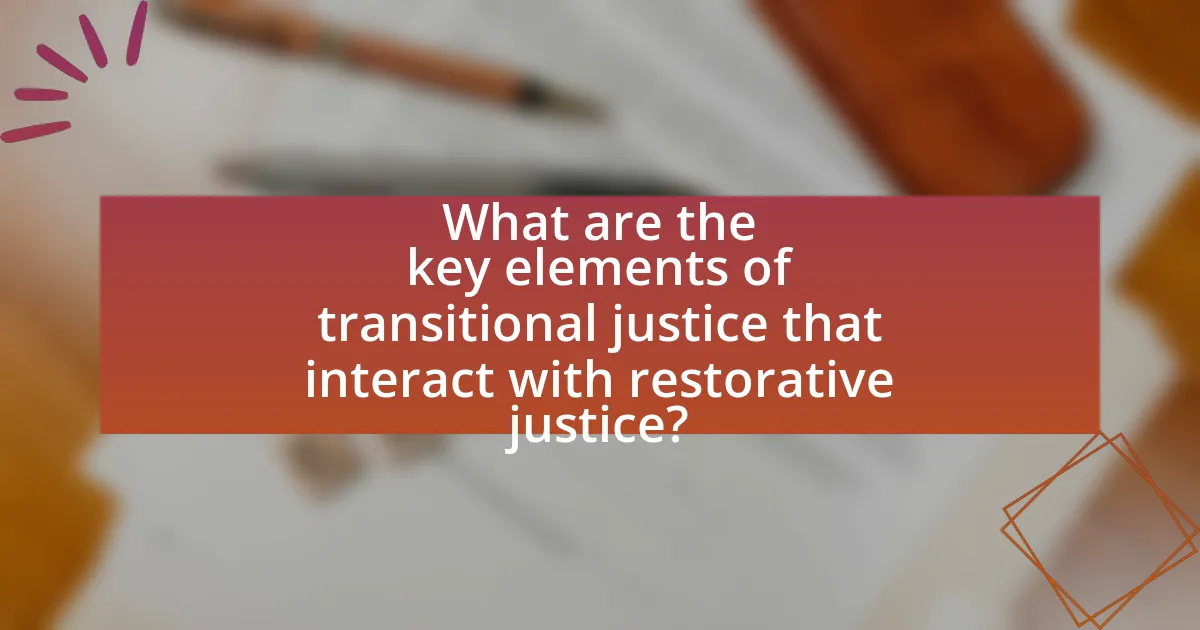
What are the key elements of transitional justice that interact with restorative justice?
The key elements of transitional justice that interact with restorative justice include truth-seeking, accountability, reparations, and institutional reform. Truth-seeking mechanisms, such as truth commissions, aim to uncover the facts about past human rights violations, which aligns with restorative justice’s focus on acknowledging harm and fostering dialogue. Accountability processes, including trials and prosecutions, serve to hold perpetrators responsible while also providing victims with a sense of justice, reflecting restorative justice principles of repairing relationships. Reparations, whether financial or symbolic, address the needs of victims and contribute to healing, a core aspect of restorative justice. Lastly, institutional reform seeks to prevent future violations by transforming systems that enabled past abuses, thereby promoting a culture of respect for human rights, which is essential for restorative justice to thrive. These elements collectively enhance the effectiveness of both transitional justice and restorative justice in addressing the aftermath of conflict and promoting societal healing.
How do truth commissions relate to restorative justice frameworks?
Truth commissions are integral to restorative justice frameworks as they facilitate truth-telling, acknowledgment of harm, and promote reconciliation in post-conflict societies. These commissions gather testimonies from victims and perpetrators, creating a public record of past abuses, which aligns with restorative justice’s focus on repairing relationships and fostering healing rather than solely punishing offenders. For instance, the South African Truth and Reconciliation Commission, established in the 1990s, exemplifies this relationship by allowing victims to share their experiences, which contributed to national healing and the establishment of a shared historical narrative. This process not only addresses individual grievances but also encourages societal reflection and collective responsibility, key components of restorative justice.
What legal provisions support the establishment of truth commissions?
Legal provisions that support the establishment of truth commissions include national laws, international treaties, and constitutional mandates. For instance, many countries have enacted specific legislation that outlines the formation, powers, and functions of truth commissions, such as South Africa’s Promotion of National Unity and Reconciliation Act of 1995. Additionally, international human rights instruments, like the United Nations’ Basic Principles and Guidelines on the Right to a Remedy and Reparation, provide a framework that encourages states to establish truth commissions as part of their obligations to address past human rights violations. These legal frameworks ensure that truth commissions operate within a recognized legal context, promoting accountability and restorative justice in transitional societies.
How do truth commissions facilitate restorative justice outcomes?
Truth commissions facilitate restorative justice outcomes by providing a platform for victims to share their experiences and for perpetrators to acknowledge their actions, fostering dialogue and understanding. This process promotes healing and reconciliation within communities affected by conflict or systemic injustice. For instance, the South African Truth and Reconciliation Commission, established in 1995, allowed victims to testify about human rights violations, which not only validated their suffering but also encouraged accountability from perpetrators. Such mechanisms contribute to societal healing by addressing grievances and promoting a collective memory, essential for preventing future conflicts.
What role do reparations play in the legal frameworks of restorative justice?
Reparations serve as a crucial component in the legal frameworks of restorative justice by addressing the harm caused to victims and facilitating their healing process. In restorative justice, reparations are designed to acknowledge the suffering of victims, promote accountability among offenders, and restore relationships within the community. For instance, legal frameworks often incorporate reparative measures such as financial compensation, community service, or public apologies, which are aimed at restoring dignity to victims and fostering social cohesion. Research indicates that effective reparations can lead to improved psychological well-being for victims and contribute to societal reconciliation, as seen in post-conflict societies like South Africa, where reparations were integral to the Truth and Reconciliation Commission’s efforts.
What types of reparations are typically included in these frameworks?
Reparations in legal frameworks for implementing restorative justice in transitional justice typically include financial compensation, restitution of property, rehabilitation services, and public acknowledgment of harm. Financial compensation provides victims with monetary support for their suffering, while restitution involves returning property or assets taken during conflicts. Rehabilitation services focus on psychological and medical support to help victims recover, and public acknowledgment serves to validate the experiences of victims and promote societal healing. These elements are essential for addressing the injustices faced by individuals and communities affected by past atrocities.
How do legal frameworks ensure the implementation of reparations?
Legal frameworks ensure the implementation of reparations by establishing clear legal obligations for states to compensate victims of human rights violations. These frameworks often include specific laws, regulations, and international treaties that mandate reparations, such as the United Nations Basic Principles and Guidelines on the Right to a Remedy and Reparation, which outlines the types of reparations that should be provided, including restitution, compensation, rehabilitation, and satisfaction. Additionally, legal frameworks create mechanisms for victims to seek redress, such as courts or truth commissions, which facilitate the enforcement of reparations and hold perpetrators accountable. For instance, countries like South Africa have incorporated reparative measures into their post-apartheid legal system, demonstrating how legal structures can operationalize reparations effectively.
How do legal frameworks address the needs of victims and offenders?
Legal frameworks address the needs of victims and offenders by establishing mechanisms that promote restorative justice principles, which focus on repairing harm and fostering dialogue. These frameworks often include provisions for victim support services, such as counseling and compensation, while also emphasizing rehabilitation programs for offenders to reintegrate them into society. For instance, many jurisdictions implement restorative justice programs that facilitate meetings between victims and offenders, allowing for personal accountability and healing. Research indicates that such approaches can lead to higher satisfaction rates among victims and lower recidivism rates for offenders, demonstrating the effectiveness of legal frameworks in meeting the needs of both parties.
What legal rights do victims have within restorative justice frameworks?
Victims within restorative justice frameworks have the legal right to participate in the restorative process, express their needs and concerns, and receive restitution or compensation for their losses. These rights are often enshrined in legislation that governs restorative justice practices, which aim to empower victims and provide them with a voice in the justice process. For instance, many jurisdictions recognize the importance of victim impact statements, allowing victims to articulate the effects of the crime on their lives, thereby ensuring their perspectives are considered in the resolution of the case. Additionally, victims may have the right to be informed about the proceedings and to seek support services throughout the process, reinforcing their role and agency in restorative justice initiatives.
How are offenders held accountable in restorative justice legal frameworks?
Offenders are held accountable in restorative justice legal frameworks through a process that emphasizes dialogue, reparative actions, and community involvement. In these frameworks, accountability is achieved by requiring offenders to acknowledge their wrongdoing, understand the impact of their actions on victims and the community, and actively participate in making amends. This often includes restitution, community service, or other forms of reparative justice that directly address the harm caused. Research indicates that restorative justice practices can lead to higher satisfaction rates among victims and lower recidivism rates among offenders, demonstrating the effectiveness of this approach in fostering accountability.
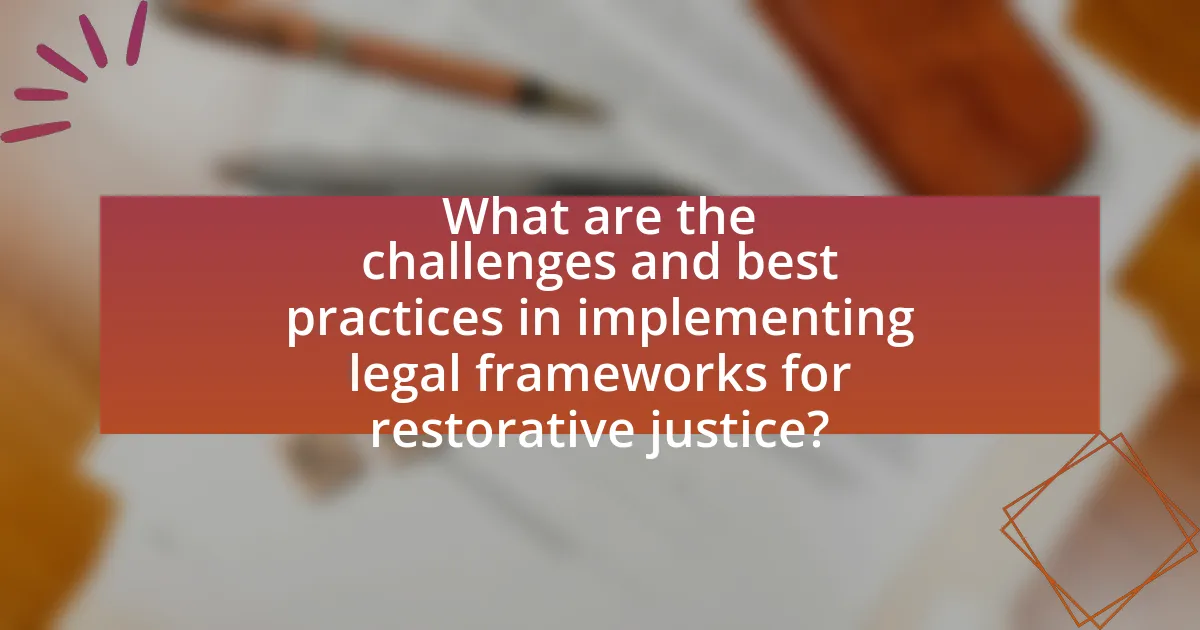
What are the challenges and best practices in implementing legal frameworks for restorative justice?
Implementing legal frameworks for restorative justice faces challenges such as lack of understanding among stakeholders, insufficient training for facilitators, and resistance from traditional punitive justice systems. These challenges hinder effective integration and acceptance of restorative practices within existing legal structures. Best practices include comprehensive training programs for practitioners, community engagement to foster support, and the establishment of clear guidelines that align restorative justice principles with legal standards. Research indicates that jurisdictions that prioritize education and community involvement see higher success rates in restorative justice initiatives, as evidenced by studies conducted in New Zealand and Canada, where restorative justice has been effectively integrated into the legal system.
What common obstacles do legal frameworks face in transitional justice?
Legal frameworks in transitional justice commonly face obstacles such as lack of political will, insufficient resources, and societal resistance. Political will is often undermined by power dynamics, where those in authority may resist accountability measures to protect their interests. Insufficient resources hinder the implementation of legal processes, as funding and personnel are critical for effective justice systems. Societal resistance arises from divisions within communities, where differing narratives about past injustices can lead to conflict over the legitimacy of legal frameworks. These obstacles impede the establishment of restorative justice mechanisms, which are essential for addressing historical grievances and fostering reconciliation.
How can these obstacles be overcome through legal reforms?
Obstacles in implementing restorative justice in transitional justice can be overcome through targeted legal reforms that establish clear guidelines and frameworks. These reforms can include enacting laws that define restorative justice processes, ensuring victim participation, and providing legal protections for all parties involved. For instance, countries like South Africa have successfully integrated restorative justice principles into their legal systems post-apartheid, demonstrating that legal frameworks can facilitate reconciliation and healing. Additionally, research indicates that legal reforms that prioritize community involvement and restorative practices lead to more effective justice outcomes, as seen in various international case studies.
What role does community involvement play in addressing these challenges?
Community involvement is crucial in addressing challenges within the legal frameworks for implementing restorative justice in transitional justice. Engaging local communities fosters trust, enhances participation, and ensures that the justice process reflects the needs and values of those affected. Research indicates that community-led initiatives can lead to more effective conflict resolution and healing, as they empower individuals to take an active role in the justice process. For instance, a study by the United Nations Development Programme highlights that community engagement in transitional justice mechanisms increases accountability and promotes social cohesion, ultimately contributing to sustainable peace.
What best practices can enhance the effectiveness of legal frameworks for restorative justice?
Best practices that can enhance the effectiveness of legal frameworks for restorative justice include integrating restorative principles into existing legal systems, ensuring community involvement, and providing adequate training for practitioners. Integrating restorative principles allows for a more holistic approach to justice, focusing on healing rather than punishment, which has been shown to reduce recidivism rates by up to 30% in various studies. Community involvement fosters a sense of ownership and accountability, as evidenced by programs in New Zealand where community-led initiatives have led to higher satisfaction rates among victims and offenders. Additionally, training practitioners in restorative justice techniques equips them with the necessary skills to facilitate effective dialogues, as demonstrated by the success of trained mediators in reducing conflict in restorative settings.
How can stakeholder engagement improve legal framework implementation?
Stakeholder engagement can significantly improve legal framework implementation by fostering collaboration and ensuring that diverse perspectives are considered in the process. Engaging stakeholders, such as community members, legal experts, and affected parties, enhances the legitimacy and acceptance of the legal framework, leading to more effective enforcement and compliance. Research indicates that inclusive stakeholder participation can lead to better-informed policies, as seen in the case of the Truth and Reconciliation Commission in South Africa, where community involvement was crucial in shaping restorative justice practices. This collaborative approach not only builds trust but also aligns the legal framework with the needs and values of the community, ultimately facilitating smoother implementation.
What lessons can be learned from successful restorative justice initiatives?
Successful restorative justice initiatives demonstrate the importance of community involvement in the healing process. Engaging victims, offenders, and community members fosters accountability and promotes dialogue, which can lead to more meaningful resolutions. Research indicates that programs like the New Zealand Family Group Conferences have significantly reduced recidivism rates by emphasizing restorative practices over punitive measures. Additionally, successful initiatives highlight the need for trained facilitators who can guide discussions and ensure that all voices are heard, thereby enhancing the effectiveness of the restorative process. These lessons underscore the value of collaboration and support systems in achieving restorative justice outcomes.
What practical steps can be taken to strengthen legal frameworks for restorative justice?
To strengthen legal frameworks for restorative justice, jurisdictions should enact comprehensive legislation that explicitly incorporates restorative principles and practices. This includes defining restorative justice processes within legal statutes, ensuring that victims, offenders, and communities have a clear role in the justice process. Additionally, training law enforcement and judicial personnel on restorative justice practices is essential, as evidenced by studies showing that informed practitioners are more likely to implement restorative approaches effectively. Furthermore, establishing monitoring and evaluation mechanisms can provide data on the effectiveness of restorative justice initiatives, allowing for continuous improvement and adaptation of legal frameworks.

